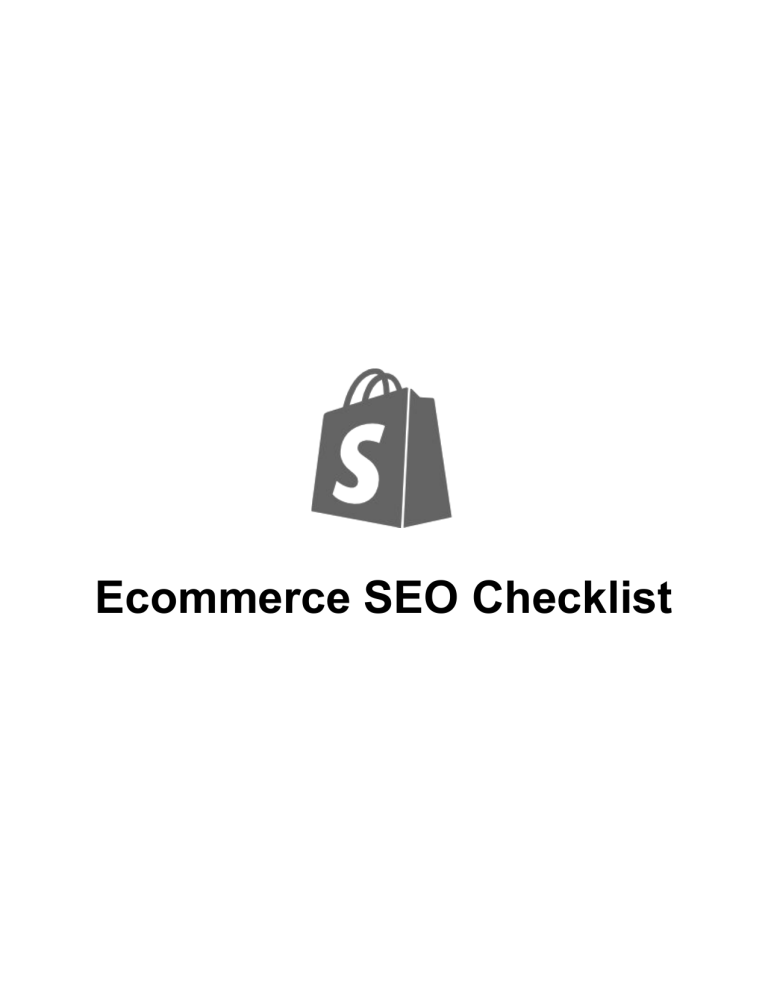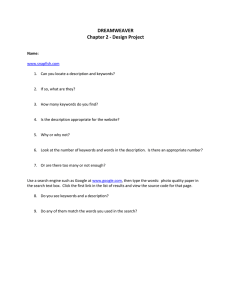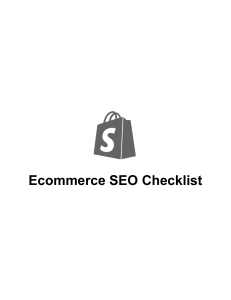
Ecommerce SEO Checklist Setup Recommended Tools ▢ Install Google Analytics . ▢ Install Google Webmaster Tools . ▢ Install Bing Webmaster Tools . Webmaster Tools ▢ Create an XML sitemap and submit it to Google and Bing through your Webmaster Tools accounts you just created. All Shopify stores automatically generate a sitemap. (www.yourstore.com/sitemap.xml) ▢ Use Google Webmaster Tools to check for 404/500 errors, duplicate content, or any crawling errors. If you get any errors, work to fix them immediately. Keyword Research ▢ Use Google’s Keyword Planner to determine the search volume of keywords and get keyword ideas to try and rank for. What would you search to find your products? What do you think your customers search? Use the Keyword Planner to determine the search volume for different keywords and phrases. From there, the keywords and phrases that have the highest searches should be the keywords and phrases you are focused on ranking for. Page Optimizations ▢ Ensure you are using one, and only one, H1 tag on your pages. H1 (header 1) tags often used as the main headline for a page and they usually contain the page’s main keywords. ▢ Ensure H1 tags are used before other header tags (H2, H3, H4). Your header tags should be used in a hierarchal order. For example, H1 tag text above H2 tag text and H2 tag text above H3 tag text, and so on. ▢ Keep your page titles under 70 characters so they aren’t truncated in results. ▢ Write good page titles that are human­readable. Make sure they include the keywords you are trying to rank for but don’t over­optimize or make it a string of keywords. ▢ Keep your meta description under 150 characters. This is the text under a page title in a search result. Ensure it clearly describes the page and also include keywords but again, don’t over optimize. Each page’s meta description should be unique. ▢ Ensure you include a keyword in your page URL. Again, don’t over do it. ▢ Ensure your images have descriptive ALT tags and filenames. ▢ Try to avoid underscores ( _ ) in URLs and use dashes ( ­ ) sparingly. Backlinks ▢ Create a link building strategy. Link building is the process of getting other websites to link back to you. Search engines such as Google see this as a factor in terms of your website’s authority. The more websites that link back to your store or specific pages on your store, generally the higher Google will rank those pages for particular keywords. R ead our guide on backlinks . ▢ View your competitors’ backlinks and SEO. Use a tool such as O pen Link Profiler to see who’s linking to your competition and similar stores, and reach out to these websites and get them to link to you. Use a tool like O pen Site Explorer or Ahrefs to see how well a competing or similar website is optimized, their domain authority and what they’re doing right. ▢ Get links from press. Read our guide on hacking the press to land your store on other websites. Content ▢ Create a content strategy . What are keywords and phrases your customers might be searching for when doing research just before buying your product? Create high quality content on a regular basis around those topics so that potential customers discover you. For example, if you’re selling guitars, you might want to write blog posts on topics such as “how to learn guitar for complete beginners”, “the 5 best guitar chords to learn for beginners”, or “how to change strings on your guitar in 5 minutes”. ▢ Ensure every page on your website has at least 250 words of descriptive text. Search engines like Google crawl and index pages based on what those pages are telling them. If you aren’t doing a good job of including enough words (and keywords you want to rank for) on each page, then you will have a more difficult time ranking for those keywords. ▢ Informational pages and blog posts should have at least 500 words. I n general, if you can write more, you should. You also don’t want to artificially increase the word count because that won’t help. Quality is more important than quantity. ▢ Avoid duplicate content. For examples, if you have more than one page with the same product description, it’s a good idea to use the canonical tag on those pages. Shopify allows you to easily do this through themes customization . ▢ Write unique product descriptions. Keeping with the last point, all content on your website should be unique and written by you. For example, don’t use product descriptions from manufacturers. ▢ Consider adding product reviews to your product pages. This will add more content to your product pages and help them rank for long tail keywords. ▢ Setup redirects. Don’t delete pages or content without first setting up a redirect. Even if you remove a product that no longer exists or that you no longer sell, setup a redirect so that any indexed page gets redirected. If you don’t know where to redirect the page, simply redirect it to your homepage. To add a redirect in Shopify, read our documentation on how to easily set one up . Reputation Building ▢ Setup your business on other platforms such as Facebook, Twitter, LinkedIn and Google+. Try to ensure you register the brand name so that the URL appears as Facebook.com/BusinessName. This helps customers find you when they search “Business Name” in their favorite search engine. ▢ Create business profiles on review sites and sites that will allow you to manage your reputation. For example, Amazon, Google Places, CustomerSearch, Yelp, FourSquare, and Epinions. This helps by allowing a backlink to your website and ranking for searches such as “Business Name Review”. Other Ranking Factors ▢ Ensure your store is mobile friendly. Every Shopify theme is mobile responsive, but if you’re not using Shopify, check to see how it looks on a mobile device. ▢ Ensure your store is fast. Speed is a ranking factor, use G oogle Page Speed Tools to see how your store’s performance can be optimized. ▢ When in doubt, refer to Google’s official accepted SEO practices. There are a lot of questionable practices out there that can get your site penalized if you’re not careful. When you start to get more comfortable with SEO and you start to do more research, make sure you do your due diligence before applying any new “SEO techniques” to your website.






